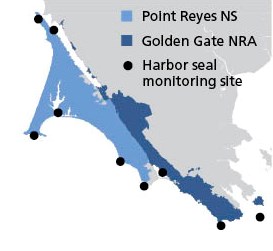Last updated: May 7, 2018
Article
Harbor Seal Monitoring in the San Francisco Bay Area


Why Are Harbor Seals Important?
Of more than 30 marine mammals known to visit Point Reyes National Seashore and the Golden Gate National Recreation Area, harbor seals are the only year-round residents, and are also the most numerous and widespread. In fact, Point Reyes is home to the highest concentration of harbor seals in mainland California. Because factors such as El Niño events, sea level rise, storm surges, changes in prey availability, and human activities can all affect these key coastal predators, studying them can provide important insights into the health of the larger marine ecosystem.
The National Park Service, with the help of many dedicated volunteers and collaborators, has been monitoring harbor seals at sites in Golden Gate and Point Reyes every year since 1995. Various groups began monitoring some of the larger colonies in the mid-1970’s.
Why Do We Monitor Harbor Seals?
- To detect long-term trends in harbor seal population size and pupping success
- To identify human activities or environmental factors that may affect seal population trends and pupping success
How Do We Use the Monitoring Data?
- To better understand how changes in ocean conditions, including those associated with climate change, affect harbor seals
- To guide park management such as protection of colonies
- To combine data with larger regional surveys to determine the status and trends of the California population of harbor seals

NOAA / Dan Linehan
What Have We Learned?
The harbor seal population at Golden Gate and Point Reyes has increased since the passage of the Marine Mammal Protection Act in 1972, which effectively curtailed their exploitation. Numbers have mostly stabilized in recent years, although El Niño years have been associated with declines in pups born at colonies. Climate change models predict that El Niño events will increase in number and intensity, which may have longer-term negative impacts. Disturbances by hikers and boaters are also an ongoing concern at some sites, though there has been a significant reduction in disturbances at Point Bonita after the decision to protect the colony from visitors in 2007.
For More Information
Point Reyes Wildlife Technician
Sarah Codde
Links
San Francisco Bay Area Inventory & Monitoring Network
Pacific Coast Science & Learning Center
Summary by Jessica Weinberg McClosky, May 2014.
Download PDF from the Data Store
